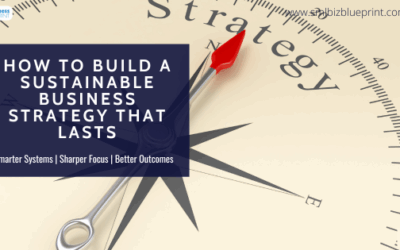In business, mastering effective leadership is key to driving success and growth.
Jack Welch, the legendary CEO of General Electric, transformed the company into one of the most valuable enterprises in the world through his innovative leadership strategies. His principles are not just applicable to large corporations but can be adapted to benefit small businesses and individuals alike.
This blog post delves into ten core leadership principles championed by Welch, providing actionable insights on how they can be tailored to enhance personal and professional growth in a small business context.
From fostering a boundaryless organisation to maintaining cost efficiency, discover how these timeless strategies can empower you to control your destiny and achieve unparalleled success.

#1 Embracing a Boundaryless Organization
In leadership, Jack Welch’s concept of a boundaryless organisation stands as a beacon of innovation and collaboration. Adopting this principle can lead to significant growth and enhanced efficiency for small businesses.
But what exactly does a boundaryless organisation entail, and how can you implement this strategy within your business?
What is a Boundaryless Organization?
A boundaryless organisation dismantles traditional barriers between departments, roles, and hierarchies to foster open communication and collaboration.
This approach encourages the free flow of ideas and information, which can lead to more innovative solutions and a more cohesive team.
Key Benefits for Small Businesses:
Enhanced Collaboration: Breaking down silos allows team members to work together more effectively, leveraging diverse skills and perspectives to tackle challenges.
Increased Innovation: Open communication makes employees feel more comfortable sharing creative ideas, leading to a culture of continuous improvement.
Greater Agility: A boundaryless structure enables quicker decision-making and faster responses to market changes, a crucial advantage for small businesses.
How to Implement a Boundaryless Organization:
Encourage Open Communication: Foster a culture where employees feel safe to voice their opinions and ideas. Regular team meetings, suggestion boxes, and open-door policies can help achieve this.
Use Collaborative Tools: Leverage technology to break down physical and organisational barriers. Tools like Slack, Trello, and Asana can facilitate real-time collaboration and project management.
Cross-Functional Teams: Create teams with members from different departments to work on projects. This brings diverse skills to the table and helps employees understand different aspects of the business.
Leadership by Example: Leaders should model the behaviour they want to see. Being approachable and transparent, leaders can set the tone for a boundaryless culture.
Adopting a boundaryless organisation can transform your small business, improving collaboration, innovation, and agility. By fostering open communication, utilising collaborative tools, forming cross-functional teams, and leading by example, you can break down barriers and create a more dynamic and successful business environment.
#2 Speed and Simplicity
In today’s fast-paced business environment, the ability to move quickly and maintain simplicity in operations is crucial. Jack Welch championed the principles of speed and simplicity as fundamental to driving success.
For small businesses, these principles can significantly enhance efficiency and competitiveness.
Why Speed and Simplicity Matter:
Enhanced Agility: Speed allows businesses to adapt quickly to market changes, capitalise on new opportunities, and respond effectively to customer needs.
Improved Efficiency: Simplified processes reduce complexity, making it easier for teams to execute tasks and achieve goals without unnecessary hurdles.
Competitive Advantage: Being able to act swiftly and maintain straightforward operations can set your business apart from competitors bogged down by bureaucracy and inefficiency.
Strategies for Implementing Speed and Simplicity:
Streamline Processes: Identify and eliminate unnecessary steps in your workflows. Use tools like process mapping to visualise and simplify complex procedures.
Example: Automate repetitive tasks with software solutions like Zapier or Make to save time and reduce manual effort.
Empower Decision-Making: Delegate authority to team members to make decisions within their areas of expertise. This reduces bottlenecks and speeds up the decision-making process.
Example: Establish clear guidelines for decision-making and empower managers to act without waiting for top-level approvals.
Prioritise Tasks: Focus on high-impact activities that drive the most value for your business. Use techniques like the Eisenhower Matrix to prioritise tasks based on urgency and importance.
Example: Regularly review and adjust your to-do list to ensure you work on the most critical tasks.
Adopt Agile Methodologies: Implement agile project management practices to enhance flexibility and speed in executing projects. Agile frameworks like Scrum or Kanban can help teams deliver faster and more efficiently.
Example: Hold daily stand-up meetings to review progress and address any impediments quickly.
Simplify Communication: Clear and concise communication ensures everyone understands their roles and responsibilities. Avoid jargon and keep instructions straightforward.
Example: Use bullet points and visual aids in internal communications to enhance clarity.
Speed and simplicity are not just buzzwords; they are powerful principles that can drive your small business to new heights.
Streamlining processes, empowering decision-making, prioritising tasks, adopting agile methodologies, and simplifying communication can create a more responsive and efficient business.
Embrace these principles to stay ahead in a competitive market and achieve sustainable growth.
#3 Candour and Transparency
As championed by Jack Welch, candour and transparency are cornerstones of effective leadership. For small businesses, fostering a culture of honesty and openness can lead to stronger teamwork, better decision-making, and increased trust.
Implementing these principles can significantly enhance your business’s internal dynamics and external reputation.
The Importance of Candour and Transparency:
Enhanced Trust: Open communication builds trust among team members, creating a more cohesive and motivated workforce.
Improved Decision-Making: Businesses can make better-informed decisions when employees feel free to share their thoughts and feedback.
Stronger Relationships: Transparency with customers and stakeholders fosters loyalty and long-term relationships.
Strategies for Fostering Candour and Transparency:
Encourage Open Dialogue: Create an environment where employees feel safe to speak their minds without fear of retribution. Regularly solicit feedback and make it clear that all voices are valued.
Example: Hold town hall meetings or anonymous surveys to gather honest feedback from your team.
Lead by Example: Demonstrate candour and transparency in your actions. Be open about your decision-making processes and share your successes and failures with your team.
Example: Share your thought process and rationale behind key business decisions during team meetings.
Provide Constructive Feedback: Offer regular, constructive feedback to your team members. Be honest about areas for improvement while also recognising and celebrating their achievements.
Example: Implement a structured performance review system that includes both positive reinforcement and areas for growth.
Transparent Communication: Maintain transparency in your communications with customers and stakeholders. Clearly convey your business’s values, goals, and any changes that may affect them.
Example: Use newsletters or social media updates to keep customers informed about new developments, product changes, or company news.
Accountability: Hold yourself and your team accountable for their actions. When mistakes are made, address them openly and work together to find solutions.
Example: When a project doesn’t go as planned, conduct a post-mortem meeting to discuss what went wrong and how to improve.
Candour and transparency are about being open and building a culture where trust, honesty, and constructive feedback thrive.
You can create a more resilient and trustworthy small business by encouraging open dialogue, leading by example, providing constructive feedback, maintaining transparent communication, and fostering accountability.
Embrace these principles to enhance your internal culture and strengthen customer and stakeholder relationships.

#4 Differentiation
In the competitive business landscape, standing out is crucial for success. Jack Welch’s principle of differentiation emphasises the importance of recognising and nurturing top performers while addressing underperformance.
For small businesses, applying this principle can lead to a more motivated and productive team.
Why Differentiation Matters:
Talent Retention: Recognizing and rewarding top performers helps retain talent and keeps employees motivated.
Improved Performance: Addressing underperformance ensures that all team members contribute effectively to the business.
Optimal Resource Allocation: Differentiation allows businesses to allocate resources more effectively, focusing on areas that yield the highest returns.
Strategies for Implementing Differentiation:
Identify Top Performers: Regularly assess your team to identify high performers. Use metrics and performance reviews to track achievements and contributions.
Example: Implement a performance appraisal system that evaluates employees based on clear, measurable criteria.
Reward Excellence: Create a reward system that recognises and incentivises top performers. This could include bonuses, promotions, or public recognition.
Example: Establish an Employee of the Month program to highlight outstanding contributions.
Provide Development Opportunities: Offer training and development programs to help underperforming employees improve. Invest in their growth to boost overall team performance.
Example: Provide access to online courses, workshops, or mentorship programs tailored to individual needs.
Set Clear Expectations: Clearly communicate performance expectations to all team members and ensure everyone understands what is required to succeed.
Example: Develop and share detailed job descriptions and performance benchmarks.
Regular Feedback: Offer continuous feedback rather than waiting for annual reviews. Regular check-ins help employees stay on track and address issues promptly.
Example: Hold quarterly one-on-one meetings to discuss progress, set goals, and provide constructive feedback.
Differentiation is a powerful tool for enhancing team performance and achieving business success. You can create a motivated and high-performing team by identifying top performers, rewarding excellence, providing development opportunities, setting clear expectations, and offering regular feedback.
Embrace this principle to optimise resource allocation and drive your small business toward sustained growth and success.
#5 Empowerment and Accountability
Jack Welch highlights that empowerment and accountability are crucial elements of effective leadership.
For small businesses, fostering a culture where employees are empowered to make decisions and held accountable for their actions can lead to increased motivation, innovation, and overall success.
The Importance of Empowerment and Accountability:
Increased Motivation: Employees who feel empowered are likelier to take initiative and show enthusiasm for their work.
Enhanced Innovation: Empowered employees are more willing to take risks and propose new ideas, driving innovation within the business.
Improved Performance: Holding employees accountable ensures they remain focused on their goals and responsibilities.
Strategies for Implementing Empowerment and Accountability:
Delegate Authority: Trust your employees with decision-making power within their roles. Provide the necessary resources and support to help them succeed.
Example: Assign project leads and give them the autonomy to make key decisions and manage their teams.
Set Clear Goals: Establish clear, measurable goals for employees to ensure they understand their expectations. This clarity helps them stay focused and aligned with the business objectives.
Example: Use SMART (Specific, Measurable, Achievable, Relevant, Time-bound) criteria to set individual and team goals.
Provide Necessary Resources: Ensure employees have the tools, training, and support to perform their duties effectively. Empowerment is ineffective without the right resources.
Example: Invest in training programs, software, and equipment that enhance productivity and skill development.
Encourage Ownership: Involve employees in the planning and decision-making processes to promote a sense of ownership. When they feel invested in the outcomes, they are more likely to take responsibility for their work.
Example: Involve employees in strategic planning sessions and solicit their input on business initiatives.
Implement Accountability Systems: Establish systems to track performance and hold employees accountable for their actions. Regular reviews and feedback sessions help maintain accountability.
Example: Use performance management software to monitor progress and conduct regular performance reviews.
Empowerment and accountability are essential for fostering a motivated, innovative, high-performing team. Small businesses can create a culture of empowerment that drives success by delegating authority, setting clear goals, providing necessary resources, encouraging ownership, and implementing accountability systems.
Embrace these principles to enhance employee engagement and achieve your business objectives.
#6 Continuous Learning and Development
In the ever-evolving business landscape, the commitment to continuous learning and development is vital for sustaining growth and staying competitive. Jack Welch emphasised the importance of fostering a culture of continuous improvement.
Investing in employees’ ongoing education and development can lead to increased innovation, improved performance, and a more adaptive workforce for small businesses.
The Importance of Continuous Learning and Development:
Enhanced Skillsets: Continuous learning ensures that employees keep their skills up-to-date, enabling them to perform better and adapt to new challenges.
Increased Innovation: A learning culture encourages employees to explore new ideas and solutions, driving innovation within the business.
Employee Retention: Investing in employee development shows that the business values its team, which can boost morale and reduce turnover.
Strategies for Implementing Continuous Learning and Development:
Provide Training Programs: Offer regular training sessions and workshops to help employees develop new skills and knowledge relevant to their roles.
Example: Host monthly training sessions on new software tools, industry trends, or leadership skills.
Encourage Self-Learning: Support and encourage employees to pursue self-directed learning opportunities, such as online courses, webinars, and reading materials.
Example: Provide access to platforms like Coursera, Udemy, or LinkedIn Learning and offer stipends for course enrollments.
Create Development Plans: Work with employees to create personalised development plans that align with their career goals and the business’s needs.
Example: Schedule one-on-one meetings to discuss career aspirations and outline actionable steps for skill development.
Foster a Learning Culture: Promote a culture where continuous learning is valued and recognised. Encourage knowledge sharing and celebrate learning achievements.
Example: Implement a “Learning Spotlight” program where employees can share what they’ve learned with the team and be rewarded for their efforts.
Leverage Mentorship: Establish mentorship programs to facilitate knowledge transfer and provide guidance for less experienced employees.
Example: Pair new hires with seasoned employees to help them acclimate and learn from their experiences.
Continuous learning and development are key drivers of success in today’s fast-paced business environment.
Small businesses can cultivate a skilled, innovative, and engaged workforce by providing training programs, encouraging self-learning, creating development plans, fostering a learning culture, and leveraging mentorship.
Embrace these principles to enhance your team’s capabilities and ensure sustained growth and competitiveness.

#7 Customer Focus
Putting the customer first is crucial to any business’s long-term success. Jack Welch emphasised the importance of customer focus, ensuring customers’ needs and expectations are at the forefront of all business decisions.
This principle is vital for building loyalty, enhancing satisfaction, and driving growth for small businesses.
The Importance of Customer Focus:
Increased Loyalty: When customers feel valued and understood, they are more likely to remain loyal to your business.
Better Customer Satisfaction: Prioritizing customer needs leads to higher satisfaction rates and positive word-of-mouth.
Competitive Advantage: A customer-centric approach can differentiate your business from competitors and attract new customers.
Strategies for Implementing Customer Focus:
Understand Customer Needs: Invest time in understanding your customers’ needs, preferences, and pain points. Gather insights through surveys, interviews, and feedback forms.
Example: Conduct regular customer satisfaction surveys and analyse the results to identify areas for improvement.
Personalize Customer Experience: Tailor your products, services, and communications to meet the specific needs of different customer segments.
Example: Use customer data to personalise marketing emails, product recommendations, and customer service interactions.
Provide Exceptional Service: Ensure your customer service is responsive, helpful, and empathetic. Train your team to handle inquiries and issues promptly and professionally.
Example: Implement a customer service training program that emphasises active listening, problem-solving, and empathy.
Gather and Act on Feedback: Regularly solicit feedback from customers and use it to make informed improvements to your products and services.
Example: Set up a feedback loop where your team reviews and addresses customer suggestions and complaints.
Engage with Customers: Build strong relationships by engaging with customers through various channels, including social media, email, and in-person events.
Example: Host webinars, workshops, or Q&A sessions to directly connect with customers and address their concerns.
A strong customer focus is essential for any small business aiming for sustained success and growth.
You can create a loyal customer base that drives your business forward by understanding customer needs, personalising experiences, providing exceptional service, gathering feedback, and engaging with customers.
Embrace this principle to differentiate your business and build lasting customer relationships.
#8 Vision and Strategy
A clear vision and well-defined strategy are fundamental to achieving long-term success.
Jack Welch’s leadership emphasised the importance of having a compelling vision and a strategic plan to guide business efforts. For small businesses, articulating a vision and crafting a strategic roadmap can provide direction, inspire teams, and drive growth.
The Importance of Vision and Strategy:
Provides Direction: A clear vision sets the overall direction for the business and helps align efforts towards common goals.
Inspires Teams: A compelling vision motivates employees, creating a sense of purpose and commitment.
Guides Decision-Making: A well-defined strategy helps prioritise actions and make informed decisions that support the business’s objectives.
Strategies for Developing Vision and Strategy:
Define Your Vision: Clearly articulate your business’s long-term goals and aspirations. Your vision should be inspiring and clearly depict where you want to go.
Example: Craft a vision statement that reflects your business’s core values and future ambitions
Set Strategic Goals: Break down your vision into actionable, measurable goals. These should be specific, time-bound, and aligned with your overall mission.
Example: Set quarterly and annual goals supporting your vision, such as increasing market share by 10% or launching three new products next year.
Communicate Your Vision: Ensure your vision and strategic goals are communicated effectively to your team. Everyone should understand and be committed to the business’s direction.
Example: Hold a company-wide meeting to present your vision and strategy, and regularly update the team on progress and milestones.
Align Actions with Strategy: Ensure all business activities and decisions align with your strategic goals. This will help you maintain focus and avoid distractions.
Example: Use strategic planning tools like balanced scorecards to track performance and ensure alignment with your vision.
Review and Adjust: Review your strategic plan regularly and make adjustments as needed. The business environment is dynamic, and your strategy should be flexible to adapt to changes.
Example: Conduct quarterly strategy reviews to assess progress and make necessary adjustments to stay on track.
A clear vision and strategic plan are essential for guiding your small business towards success.
By defining your vision, setting strategic goals, communicating effectively, aligning actions, and regularly reviewing your strategy, you can create a cohesive and motivated team working towards common objectives.
Embrace this principle to provide direction, inspire your team, and achieve long-term growth.
#9 Cost Efficiency and Lean Operations
Managing resources effectively is crucial for maintaining profitability and growth in a competitive business environment.
Jack Welch’s emphasis on cost efficiency and lean operations highlights the importance of minimising waste and maximising value. Adopting these principles can lead to significant savings and more streamlined operations for small businesses.
The Importance of Cost Efficiency and Lean Operations:
Increased Profitability: Efficient use of resources reduces costs and increases profit margins.
Enhanced Competitiveness: Lean operations enable businesses to offer competitive pricing while maintaining quality.
Improved Sustainability: Cost-efficient practices contribute to long-term financial stability and growth.
Strategies for Implementing Cost Efficiency and Lean Operations:
Identify and Eliminate Waste: Review your processes regularly to identify areas where resources are being wasted. Implement changes to reduce or eliminate these inefficiencies.
Example: Conduct a value stream mapping exercise to pinpoint non-value-adding activities and streamline your processes.
Optimise Resource Use: Ensure that all resources, including time, materials, and labour, are used efficiently. This includes optimising inventory levels and reducing excess.
Example: Implement just-in-time (JIT) inventory management to minimise holding costs and reduce waste.
Automate Routine Tasks: Use automation to handle repetitive tasks, freeing your team to focus on higher-value activities.
Example: Use tools like Zapier or Make to automate workflows such as invoice processing, email marketing, and customer service inquiries.
Negotiate with Suppliers: Work with suppliers to secure better terms and pricing. Building strong relationships with suppliers can lead to cost savings and more favourable conditions.
Example: Negotiate bulk-purchasing discounts or explore alternative suppliers to reduce costs.
Monitor and Control Expenses: Regularly track and compare your expenses against your budget. This helps identify any discrepancies and areas where costs can be reduced.
Example: Use accounting software to monitor expenses in real time and generate reports for better financial control.
Cost efficiency and lean operations are essential for the sustainability and growth of small businesses.
You can create a more efficient and profitable business by identifying and eliminating waste, optimising resource use, automating routine tasks, negotiating with suppliers, and monitoring expenses.
Embrace these principles to streamline operations, enhance competitiveness, and achieve long-term success.

#10 Globalization
Globalisation offers significant business expansion and growth opportunities in today’s interconnected world.
Jack Welch recognised the importance of thinking globally and encouraged businesses to embrace international markets.
Globalisation can lead to increased revenue, diversified markets, and enhanced innovation for small businesses.
The Importance of Globalization:
Increased Revenue: Expanding into global markets can provide access to new customers and revenue streams.
Market Diversification: Globalization helps spread risk by diversifying market exposure, making the business less dependent on a single market.
Enhanced Innovation: Exposure to different cultures and markets fosters creativity and innovation, driving business growth.
Strategies for Implementing Globalization:
Research International Markets: Conduct thorough research to understand potential international markets’ demand, competition, and regulatory environment.
Example: Use market research tools and reports to gather data on target markets and identify the best opportunities for expansion.
Adapt Products and Services: Tailor your products and services to meet the needs and preferences of international customers. This may involve modifying features, packaging, or marketing strategies.
Example: Customize product offerings to align with local tastes and cultural preferences, such as offering region-specific flavours or packaging.
Leverage Digital Marketing: Utilize digital marketing strategies to reach global audiences. This includes optimising your website for international SEO, using social media, and running targeted online advertising campaigns.
Example: Create multilingual websites and use geo-targeted ads to reach customers in specific countries or regions.
Establish Partnerships: Form strategic partnerships with local businesses, distributors, or agents to facilitate market entry and growth.
Example: Partner with local distributors to navigate regulatory requirements and leverage their market knowledge and networks.
Understand Cultural Differences: Invest time in understanding the cultural nuances and business practices of the markets you are entering. This will help you build strong relationships and avoid misunderstandings.
Example: Provide cultural training for your team to ensure effective communication and collaboration with international partners and customers.
Globalisation presents vast opportunities for small businesses to expand their reach and drive growth.
By researching international markets, adapting products and services, leveraging digital marketing, establishing partnerships, and understanding cultural differences, you can successfully navigate the complexities of global expansion.
Embrace this principle to unlock new revenue streams, diversify your market presence, and foster innovation.
Conclusion:
Jack Welch’s leadership principles offer valuable insights for small businesses seeking to enhance their growth and success.
By adopting a boundaryless organisation, embracing speed and simplicity, fostering candour and transparency, differentiating talent, empowering employees, committing to continuous learning, focusing on customers, articulating a clear vision and strategy, maintaining cost efficiency, and exploring globalisation, small businesses can build a resilient and dynamic foundation.
These principles apply to large corporations and are equally transformative for small businesses. Implementing these strategies can create a motivated team, streamline operations, and foster a culture of innovation and excellence.
Ready to take your small business to the next level? Start by integrating these leadership principles into your daily operations and strategic planning.
Reflect on each principle, assess your current practices, and identify areas for improvement.
Join our newsletter for more tips and insights on successful business strategies.
Embrace the journey of continuous improvement and watch your business thrive. Control your destiny and drive your small business towards unparalleled success today!
FAQs
Q1: What is a boundaryless organisation, and how can it benefit my small business?
A1: A boundaryless organisation eliminates traditional barriers between departments and hierarchies, fostering open communication and collaboration. This approach can lead to enhanced teamwork, increased innovation, and improved efficiency, which are crucial for the growth of small businesses.
Q2: How can I implement the principle of speed and simplicity in my small business?
A2: To implement speed and simplicity, streamline your processes by eliminating unnecessary steps, delegate decision-making authority, prioritise high-impact tasks, adopt agile methodologies, and ensure clear communication. These strategies help maintain focus, improve efficiency, and allow for quick adaptation to market changes.
Q3: Why is candour and transparency important for small businesses?
A3: Candour and transparency build trust among team members and customers, improve decision-making, and strengthen relationships. By fostering a culture of honesty and openness, small businesses can create a more cohesive and motivated workforce, leading to better overall performance.
Q4: How can differentiation help improve my business’s performance?
A4: Differentiation involves recognising and rewarding top performers while addressing underperformance. This approach helps retain talent, motivates employees, and ensures optimal resource allocation. Implementing differentiation can lead to a more productive and high-performing team, driving business success.
Q5: What steps can I take to empower my employees?
A5: To empower your employees, delegate decision-making authority, set clear goals, provide necessary resources, encourage ownership, and implement accountability systems. Empowered employees are more motivated, innovative, and committed to achieving business goals.
Q6: How can continuous learning and development benefit my small business?
A6: Continuous learning and development ensure employees keep their skills up-to-date, fostering innovation and improving performance. Investing in employee development shows that you value your team, which can boost morale and reduce turnover, leading to sustained business growth.
Q7: Why is having a clear vision and strategy important for my business?
A7: A clear vision and well-defined strategy provide direction, inspire teams, and guide decision-making. They help align efforts towards common goals, ensure focus on high-priority actions, and adapt to changes in the business environment. This strategic approach is essential for long-term success.
Other Articles
Why Small Businesses Can’t Afford to Ignore Lead Generation




